Rehabilitation medicine has always been an important part of modern medicine. With the continuous influence of foreign rehabilitation medical development experience, the continuous improvement and opening up of domestic policies, new models and new technologies for rehabilitation medicine emerge one after another. The market value and market space of the rehabilitation medical industry are also growing. The Industrial Securities Research Institute has made a comprehensive and in-depth analysis report on the status of rehabilitation medical treatment at home and abroad at this stage. The Arterial Network has extracted this report.
The report analyzes the three characteristics of the current stage of domestic rehabilitation medical treatment:
- The development space is broad.
- Insufficient supply.
- The mechanism is not perfect.
The report believes that the advantages of rehabilitation in developed countries are:
- The characteristics of the rehabilitation medical service system in developed countries: a well-structured and well-functioning rehabilitation medical service system, based on a fluent and efficient rehabilitation medical service process, a medical insurance payment system based on standards and functional attention, and rehabilitation medical care centered on rehabilitation physicians The service team values ​​the joint synergy of the community and NGOs.
- The US health insurance policy has a profound impact on the development of its rehabilitation.
The report predicts that with the promotion of China's policy, capital and technology, the hundreds of billions of markets for the rehabilitation medical industry will be launched soon:
- National policies such as grading medical treatment and medical insurance have significantly enhanced the support for rehabilitation medical care.
- The cooperation between social capital and public hospitals to establish a rehabilitation hospital has become a mainstream win-win model: public secondary hospitals seek transformation, and are managed by public general hospitals, and social capital is pouring into the field of rehabilitation.
- Rehabilitation specialist hospitals have natural advantages: as a natural partner of public hospitals, improve their bed turnover rate and income, help medical insurance control fees, ease the burden of patients' payment, special hospitals have strong profitability, short profit cycle, low labor costs, and people's bargaining power is not Strong, standardized, and easy to copy and expand quickly.
- Technological advancement is the accelerator for the development of the rehabilitation medical industry: rehabilitation robots are expected to usher in spring, brain-computer interface technology (BCI) to promote disease rehabilitation, big data and virtual reality technology are applied to rehabilitation medicine, and rehabilitation medical information is steadily advanced.
The following is a summary of the main content of the report by the arterial network.
I. The status quo and market application prospects of rehabilitation medical care in China
The report analyzes the importance and value of rehabilitation medicine:
Rehabilitation medicine is an important part of the modern medical "prevention, clinical treatment, rehabilitation" trinity.

Rehabilitation medicine has obvious application value in general hospitals, such as fracture, craniocerebral injury, cerebrovascular events, diabetes, cardiovascular disease, rheumatoid arthritis, cervical spondylosis, low back and leg diseases, etc. The patient's recovery process improved the recovery effect, significantly reduced disability and mortality, and played a significant role in improving the overall clinical efficacy.
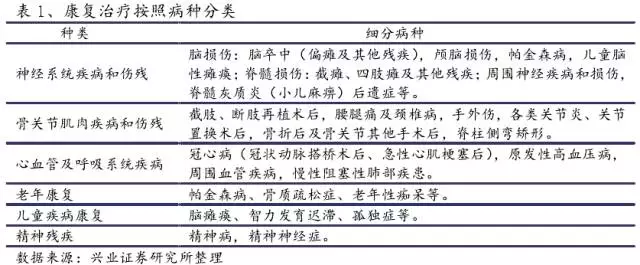
The report identifies the rehabilitation medical industry chain:
The rehabilitation medical industry chain can be roughly divided into three parts:
- Upstream is a rehabilitation device, a rehabilitation drug manufacturer
- The middle reaches are rehabilitation medical institutions including general hospital rehabilitation, rehabilitation hospitals, and community rehabilitation centers.
- The terminal is a patient who needs rehabilitation.
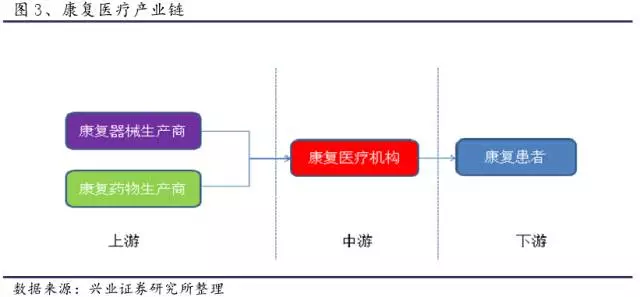
The report analyzes the current status of rehabilitation medical care in China:
The disease spectrum brought about by the aging of China's population, the high-incidence rate of the elderly, and the demand for chronic diseases, continue to expand the demand space of the rehabilitation medical industry; at present, the scale of China's per capita rehabilitation medical market is much lower than that of the United States. The market potential is huge; the supply of rehabilitation market in China is insufficient, and the institutional mechanism of rehabilitation medical services is not perfect, which restricts the development of China's rehabilitation industry.
The report analyzes the population base and market prospects of rehabilitation care in China:
The demand for rehabilitation medical care in China mainly comes from three groups:
- First, the elderly population, the high incidence of high blood pressure, diabetes, arthritis, cardiovascular and respiratory diseases and respiratory diseases are the main diseases of rehabilitation. With the aging of China, the country is 60 years old by the end of 2011. The above elderly population has reached about 190 million, of which about 70 million people need rehabilitation services.
- The second is the disabled group. According to the sixth national census and the second national sample survey of disabled people, at the end of 2010, the number of disabled people in China has reached 85.02 million, of which more than 50 million have rehabilitation needs;
- Third, patients with chronic diseases and sub-health populations need rehabilitation treatment. It is estimated that by 2030, the prevalence of chronic diseases in China will be as high as 65.7%, and 80% of patients with chronic diseases need rehabilitation.

Since 1998-2008, the incidence of residents in China has continued to rise, especially chronic diseases such as hypertension, heart disease and diabetes. According to the fourth national health service survey data in 2008, the prevalence of chronic diseases increases with age, the spectrum of diseases caused by aging changes, and the high-risk rate of the elderly themselves requires the rehabilitation of chronic diseases. The demand will continue to expand the demand space for the rehabilitation medical industry.
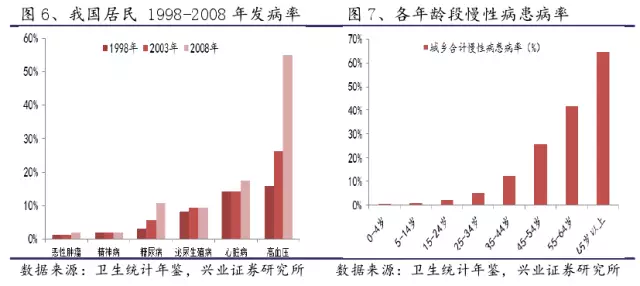
China's rehabilitation medical care is in its infancy, and its market potential is huge:
- According to statistics from 2010, the total investment of disabled persons in all levels of the country for the rehabilitation of disabled persons was 1.33 billion yuan, accounting for only 0.7% of the total public health investment in that year, accounting for 3.8 per cent of GDP in that year, and the per capita rehabilitation expenditure was only 1.1. Only 33.5% of disabled patients have received rehabilitation services, and according to the total population and health care input in the United States in 2010, the average American rehabilitation cost is 452.3 US dollars (including long-term care), which shows that compared with developed countries in China. The gap is far away, and we will continue to increase related investment in the future.
- According to the “China's Rehabilitation Medical Industry Development Prospects and Investment Forecast Analysis Report†issued by the Prospective Industry Research Institute, in 2014, the total number of communities that have built community rehabilitation stations nationwide totaled 219,000, an increase of only 2.34% over the previous year. space.
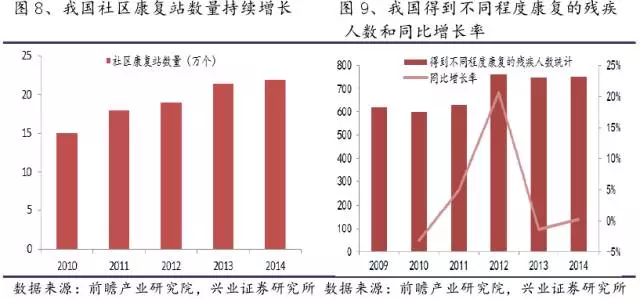
The report predicts the market size and growth rate of China in the next few years:
- In 2013, China's domestic rehabilitation medical market was only 20 billion yuan (15 yuan per capita), far lower than the US's 100 billion US dollars (about 80 US dollars per capita).
- If we calculate according to the level that basically meets China's rehabilitation needs, by 2023, the scale of China's rehabilitation medical industry is expected to reach 103.8 billion yuan.
- The compound annual growth rate is expected to be no less than 18%.
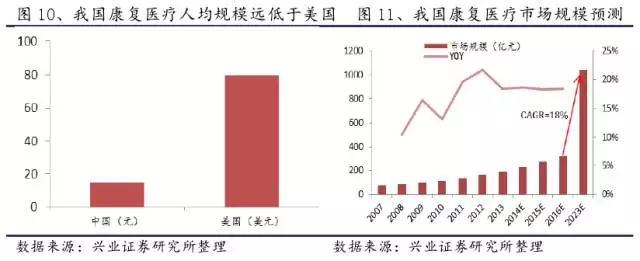

Summary: The report analyzes the data of population basis, chronic disease incidence, medical and health investment, per capita rehabilitation cost, number of community rehabilitation stations, etc., and expounds the basic situation of rehabilitation medical care in China at present, and then analyzes the market. The development of rehabilitation medical care in China in the next few years is predicted.
At present, China's rehabilitation medical care mainly has two major problems: insufficient supply and imperfect system:
1) Insufficient supply mainly includes four aspects:
- Lack of rehabilitation professionals: At present, the proportion of rehabilitation doctors in China is about 0.4:100,000, while that in developed countries is 5:100,000, which is 12.5 times. According to the requirements of the Ministry of Health, China's second- and third-tier hospitals require a total of 58,000 rehabilitation doctors, 116,000 therapists, and 902,000 community comprehensive rehabilitation personnel, which is more than 10 times that of existing rehabilitation talents. There is a huge talent gap. .
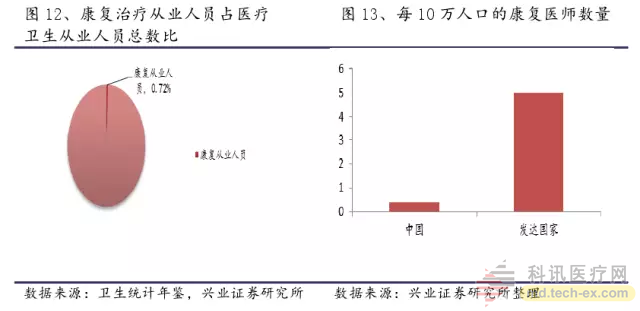
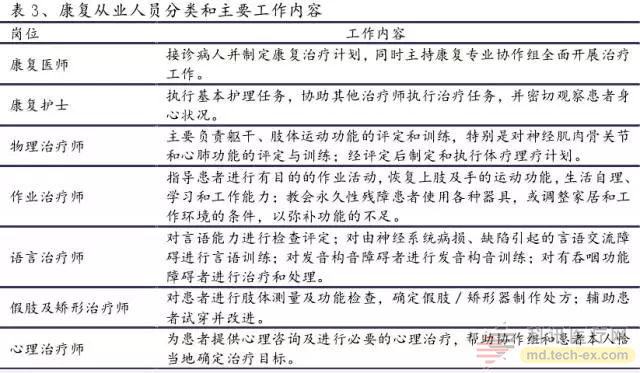
- Rehabilitation medical institutions are seriously inadequate: According to the 2012 data of the National Health and Family Planning Commission, there are currently only 322 rehabilitation hospitals in China, including 206 cities and 116 rural areas. This means that more than half of the more than 600 cities in China still do not have rehabilitation hospitals.
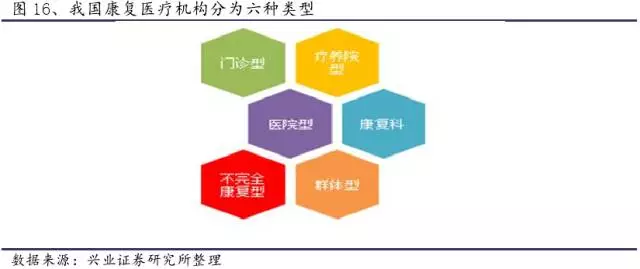
- The number of rehabilitation medical beds is small: According to the data of the Health Planning Commission, in 2012, the number of rehabilitation medical beds in China (including rehabilitation specialist hospitals and general hospital rehabilitation medicines) accounted for only about 1.75% of the total number of beds in medical institutions, accounting for a small proportion.
- Lack of rehabilitation equipment and backwardness: 51% of the hospitals in the provincial capital city hospitals in China have insufficient rehabilitation training facilities, 49.6% of the rehabilitation equipment is outdated, and there is no modern rehabilitation business management software system, which can not meet the rehabilitation treatment requirements and patient needs.

2) The imperfect system of rehabilitation medical services mainly includes three aspects:
- The early intervention of rehabilitation medicine is not timely: the so-called early rehabilitation means that after the patient is sick, as long as the vital signs are stable and conscious, the functional rehabilitation can be performed after 48 hours. Early rehabilitation intervention is a feature of the comprehensive hospital rehabilitation department, as well as the soil for survival and development, and is the basic measure to ensure the rehabilitation effect. In the United States, an emergency medical facility has been set up for early bedside rehabilitation. Due to the lack of awareness of the rehabilitation of clinicians in China, and the impact of economic interests, it is often not possible to open a rehabilitation consultation form in time, so that patients miss the opportunity of optimal rehabilitation intervention, resulting in the lack of close connection between early rehabilitation training and clinical treatment. After the acute phase The patients have not been transferred to the rehabilitation department in time, so that the rehabilitation medicine department is basically the patients with advanced disease, which increases the pressure on rehabilitation medical services.
- The two-way referral of rehabilitation medical treatment is not smooth: the general performance is that the hospital has a long hospitalization period and a low bed turnover rate. The general hospital rehabilitation medicine department is often in an overloaded state, and the inpatients who are stranded are difficult to transfer out. A large number of early patients cannot get timely. Rehabilitation medical services.
- The cost of rehabilitation medical care is high, and the medical insurance policy needs to be improved: First, medical insurance is basically for the reimbursement of medical expenses, and for the expenses of rehabilitation aids that account for a large proportion of the payment costs, it also needs personal commitment. Second, most rehabilitation treatment projects are not included in the scope of basic medical reimbursement, some medical insurance payment mechanisms do not meet the clinical needs of rehabilitation medical treatment, and third, the restrictions of medical insurance designated hospitals and the settlement methods of medical insurance reimbursement restrict the referral. Fourth, the medical insurance reimbursement policy of the rehabilitation specialist hospital, the average hospitalization day and the patient's average cost were all implemented according to the standards of the general hospital. Many rehabilitation patients were forced to leave the hospital without rehabilitation, or they were hospitalized after a period of interruption.
Summary: The report analyzes the shortcomings of China's rehabilitation medical treatment in terms of staffing, medical institutions, medical beds, medical equipment, and the early intervention in the service mechanism is not timely, the two-way referral is not smooth, the cost is high, insurance policy, etc. The problem has been explained. At the same time, it also shows some breakthrough points and links in the development of rehabilitation medical care. This has profound guiding significance on how to cut into it.

Second, the development status and characteristics of foreign rehabilitation medical care
The report provides a detailed explanation of the five characteristics of the rehabilitation medical service system in developed countries:
1) Rehabilitation medical service system with clear structure and clear function
A comprehensive three-level rehabilitation medical network is a common model for rehabilitation medical service systems in developed countries and regions:
- The US tertiary rehabilitation medical service system is broadly divided into Acute Rehabilitation, Post-Acute Care (PAC), and Long Time Care (LTC) institutions.
- The UK's tertiary rehabilitation medical service system is the emergency hospital (first diagnosis) - the government-purchased specialist rehabilitation hospital (inpatient rehabilitation) - community rehabilitation, and the rehabilitation process based on functional evaluation is established between the three institutions. Interconnected rehabilitation medical complex.
- In Hong Kong, the rehabilitation medical service system is divided into three levels: 1) regional hospitals; 2) rehabilitation hospitals/centres; 3) community rehabilitation services (day hospitals or specialist clinics); in addition, there are long-term care hospitals ( Including nursing homes and nursing homes, providing lifelong care services.
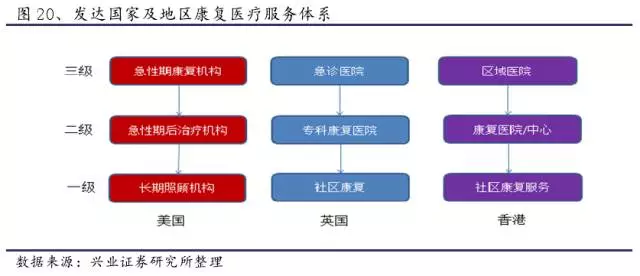
2) Evidence-based and smooth and efficient rehabilitation medical service process
There are two main points of reference for the referral process in developed countries:
- The first is the positive rehabilitation concept. Early rehabilitation in the United States is reflected in bedside rehabilitation in acute rehabilitation, implemented in non-rehabilitation departments in acute hospitals, and provides moderate-intensity rehabilitation to patients at an early stage. In the UK, clinical departments and rehabilitation departments can maintain close contact to ensure that the rehabilitation department keeps abreast of the patient's condition and ensures early intervention in rehabilitation.
- The second is a smooth referral route. In the United States, after admission to the hospital in the acute phase, the attending physician performs rehabilitation treatment according to the evaluation results of the standard independent functional scale and the patient's own tolerance; after the patient's condition is stable, he quickly goes to the acute rehabilitation ward, subacute rehabilitation ward, and professional Rehabilitation care institutions or long-term care institutions can be referred to triages; patients who can recover without inpatient rehabilitation can also be transferred to family and community agencies as soon as possible.
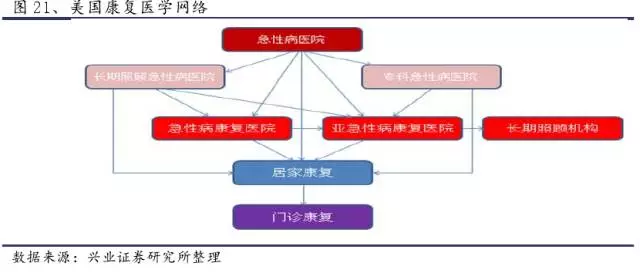
3) Medicare payment system based on standards and focusing on functions
The development and soundness of the American rehabilitation medical service system cannot be separated from the guiding role of the medical insurance payment system. The US Medicare payment is based on the Uniform Data System for Medical Rehabilitation (UDSMR), using the Independent Function Measure (FIM) as an assessment tool, and a series of functionally related classifications (FIM). -FRGs) based prepaid system. FIM-FRGs has two references:
- The first is the scientific medical insurance payment standard. FRGs group patients according to criteria, and then assess the dysfunction level, age, and complication rate of each group according to the independent functional scale, and finally measure the rehabilitation cost standard.
- Second, the basis for payment is the patient's effective functional improvement, which encourages the hospital to pay more attention to functional recovery, guide the development and improvement of rehabilitation medical institutions, meet the medical needs of patients at different levels and different treatment stages, and achieve timely, active and smooth referral of patients.
4) Rehabilitation medical service center centered on rehabilitation physicians
In areas where rehabilitation medical services are more developed, the basic unit of rehabilitation medical services is a multi-disciplinary rehabilitation medical service team:
- The US rehabilitation service team consists of a Rehabilitation Physician (PD), a Physical Therapist (PT), an Occupational Therapist (OT), a Speech Therapist (ST), a Swallow Therapist, a Psychotherapist, a Social Worker, and a Nurse. The Rehabilitation Physician (PD) acts as the central leader responsible for coordinating the entire team, developing treatment plans, and ensuring program implementation.
- In the UK, the most basic community rehabilitation is also team-based. The POT is a community rehabilitation manager with a focus on health, nursing and social professionals. It provides rehabilitation services for patients with residual physical and neurological disorders.
5) Pay attention to the joint synergy between the community and NGOs
Social workers can often be seen in a well-functioning rehabilitation medical service team:
- In Hong Kong, voluntary work is very popular. In 1997 alone, more than 2,000 patients participated in self-help groups, and more than 100 professionals and nearly 600 ordinary citizens became volunteers.
- In the United States, in addition to professional rehabilitation physicians, rehabilitation medical wards often have a social worker who is responsible for matters related to patients after discharge. If the patient needs to enter the rehabilitation center after discharge, the social worker will contact him in time.
- Social workers or discharge coordinators also play a key role in the UK POT team.
Summary: The above report summarizes the five key points of the rehabilitation medical service system in developed countries such as the United States and the United Kingdom. This has played a certain role in the development of rehabilitation medical care in China. How to cooperate and resources on the basis of absorbing the experience of developed countries Integrating and developing your own set of models is where the entire industry needs to think.
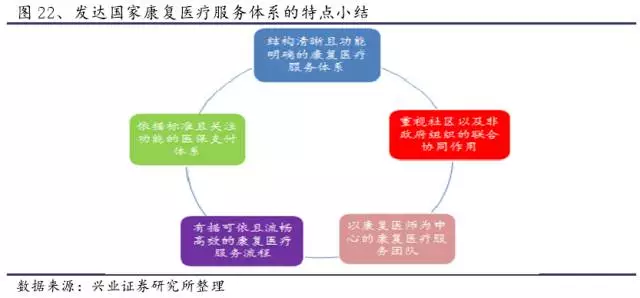
Third, analyze the trend of China's rehabilitation medical industry from three aspects: policy, capital and technology
1) National policies have significantly enhanced the support for rehabilitation medical care
National policies such as grading medical treatment and medical insurance have significantly enhanced the support for rehabilitation medical care in recent years. In 2009, the central medical reform program document "Opinions of the Central Committee of the Communist Party of China and the State Council on Deepening the Reform of the Medical and Health System" clearly stated that China's medical system should pay attention to the combination of "prevention, treatment and rehabilitation"; in 2011, the Ministry of Health document "developing and perfecting" The Notice on the Pilot Work of the Rehabilitation Medical Service System clearly proposes to establish a three-level rehabilitation medical graded diagnosis and treatment system (acute period: general hospital, rehabilitation period: rehabilitation hospital, long-term follow-up period: community hospital).
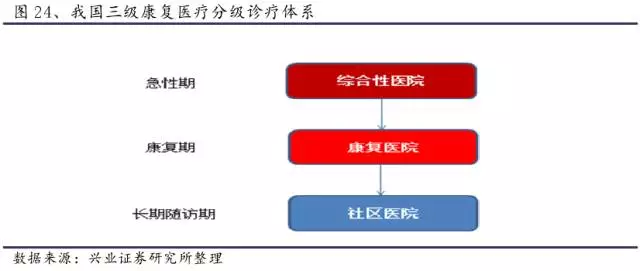
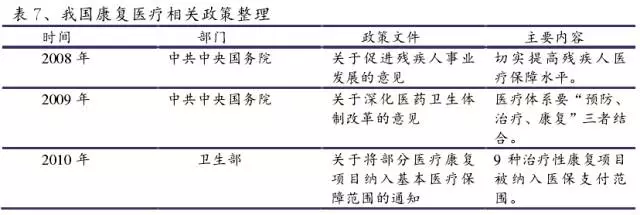
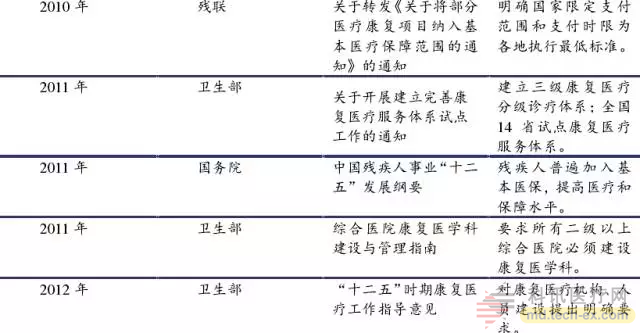

In 2010, the Ministry of Health document “Notice on Integrating Some Medical Rehabilitation Projects into the Basic Medical Insurance Scope†clearly included the nine major treatment programs for rehabilitation medical care into the scope of medical insurance payment.
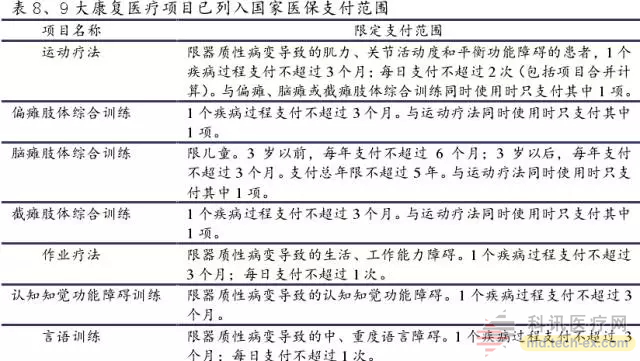

2) Introducing social capital, the rehabilitation medical industry is promising
- At the national level, social capital is encouraged to run a doctor. Considering that private capital prefers the gap in the medical system and the advantages of the layout of specialized hospitals, the rehabilitation medical field is expected to usher in a capital feast. With the increase of national policy support, rehabilitation medical care has gradually become a new outlet for medical services.
- Social capital invests in rehabilitation medical care in a variety of ways, including new construction, acquisition, and custody rehabilitation hospitals. Among them, social capital and public hospitals have established a rehabilitation hospital to become a mainstream win-win model. The social capital enters the public hospital to build a rehabilitation hospital model. The investment cost is lower than that of the new comprehensive hospital, and the profit cycle is shortened, which has a high cost performance.
- Rehabilitation hospitals are favored by social capital for their unique advantages. Unlike general hospitals with high requirements for various factors, rehabilitation hospitals have the advantages of low talent requirements, strong profitability, short profit cycle, high standardization, easy replication and expansion, etc. At the same time, rehabilitation hospitals are grafted with public hospitals to alleviate public medical systems. Difficult and expensive pain points, giving social capital a good opportunity to intervene.
3) Technological advancement is the accelerator for the development of the rehabilitation medical industry
Rehabilitation robot
- The base of physical disability in our country is huge and the number is still increasing. According to the total number of persons in the sixth national census and the second national sample survey of disabled persons, the total number of disabled persons in China as of the end of 2010 was 85.02 million, accounting for 6.2% of the total population of the country, including 2472 disabled persons. 10,000, accounting for 29.07% of the total number of disabled people, accounting for the largest proportion of all types of disabilities.
- There is a lack of supply of rehabilitation services for people with physical disabilities, and there is a huge gap in the demand for services and the needs of the disabled. According to the statistics of the Disabled Persons' Federation, as of the end of 2014, there were 6,914 rehabilitation institutions across the country, and 2,181 rehabilitation services for physical disabilities were carried out. A total of 367,000 physically disabled people were rehabilitated throughout the country, and there were more than 24 million physically disabled people in China. Therefore, there is a huge gap in the supply of rehabilitation equipment and clinical needs. Traditional manual or simple medical equipment has been unable to meet the patient's rehabilitation needs, which has led to an increase in the demand for limb rehabilitation equipment such as rehabilitation robots. Rehabilitation robots can reduce staffing and help patients recover more effectively. More importantly, patients, the elderly, and young children, the so-called "old, weak, sick and disabled", are more rigid in demand for medical rehabilitation robots, and this market demand is expected to develop in the future.
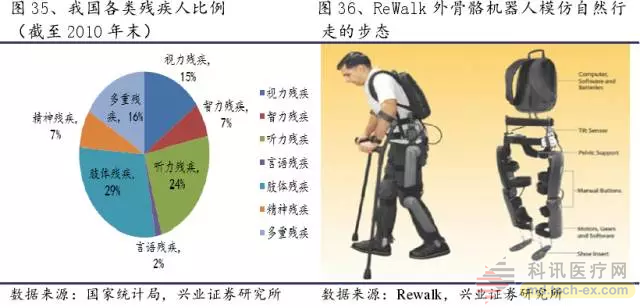
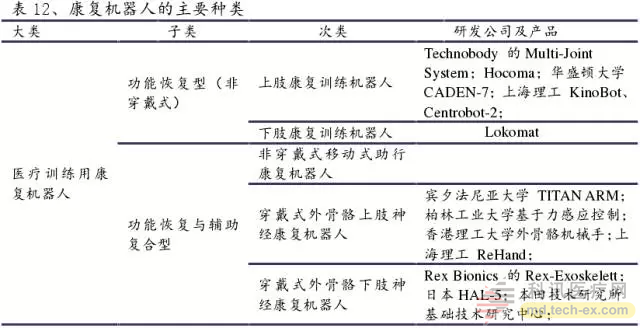
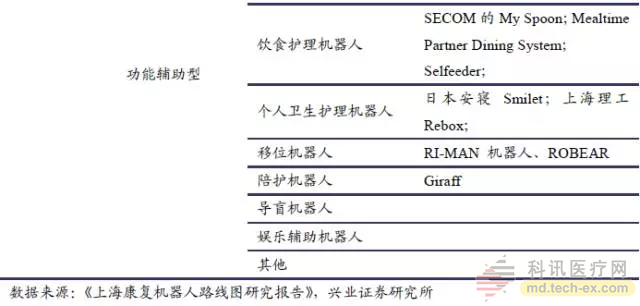
Brain Machine Interface Technology (BCI)
- Since 1929, Berger et al. proposed the concept of "reading thoughts". With the progress of brain signals, the time and space universality of neural remodeling, the real-time collection and analysis of brain signals and the development of social systems. Growth, brain computer interface (BCI) technology has developed rapidly in recent decades.
- BCI is a computer system that realizes the interaction of people with the external environment and displays or realizes people's desired behavior without the participation of normal outgoing pathways of peripheral nerves and muscles. In a sense, BCI is a rehabilitation training device. It can be used in the rehabilitation process of various diseases. There are two main ways to promote disease rehabilitation: one is to achieve multiple functions of patients with severe sputum through interaction with the environment; the second is to achieve functional compensation by promoting brain remodeling, and ultimately reduce disability and improve the quality of life of patients.
- The main operational steps of the brain-computer interface are: 1) Signal acquisition: acquiring signals and removing noise. The most reliable acquisition method is to collect human brain waves; 2) signal processing: transforming signals into a specific form; 3) characteristics Extraction and classification: Finding a specific signal, this step is the most difficult and most challenging; 4) Control interface: translates relevant features into commands and operations.
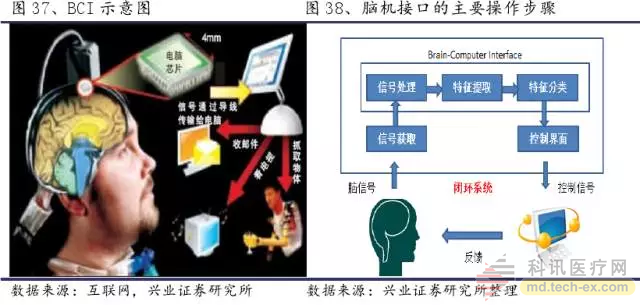
Big data and virtual reality technology (VR)
- The precision rehabilitation medical system integrates modern information science technology and intelligent network platform, such as medical Internet of Things, telemedicine and big data intelligent decision engine, based on traditional medical concepts. It senses and monitors human life characteristics through embedded wearable devices and collects them. And feedback on rehabilitation related information, issue medical intervention information and treatment plan; use the big data intelligent decision engine for analysis, mining, mathematical simulation, image analysis and other means to obtain information, transmit information, diagnose and evaluate disease in the process of diagnosis and treatment Risk, conduct intelligent judgment, decision making, display and provide interventions. Digital precision rehabilitation medicine is an expert system established through high-tech means. It is the extension and amplification of human intelligence in the medical field through machine and artificial intelligence.
- Virtual reality is a technology that produces virtual effects on human senses. It has been widely used in the field of rehabilitation therapy, such as attention deficit, spatial perception disorder, memory impairment and other cognitive rehabilitation, anxiety, depression, horror and other emotional disorders and other mental illness patients. Rehabilitation, poor balance coordination and other sports disorders, and achieved good rehabilitation results.

Rehabilitation medical information is steadily advanced
- With the development of Internet technology, the referral of patients from rehabilitation to rehabilitation will be fully realized, and information sharing will be realized among various medical institutions. Patients can be fluently transferred between tertiary rehabilitation hospitals. The tertiary rehabilitation network construction project is based on modern rehabilitation technology, with the integration of rehabilitation medical resources extended by tertiary hospitals, secondary hospitals, community service centers and community service stations. The goal is to establish medical and health institutions at all levels in the region. Rehabilitation digital diagnosis and treatment system, develop a unified rehabilitation medical treatment data platform, realize the digitization and sharing of rehabilitation information, and create an ecological circle in which patients in the region enjoy convenient and high-quality remote rehabilitation, referral, education and other services.
- On April 27, 2015, the signing and launching ceremony of the first digital rehabilitation hospital in China was held in the Sichuan Rehabilitation Hospital (May 1 Rehabilitation Center of Sichuan Province), which initiated a three-level rehabilitation network construction project covering Sichuan Province, including Other provinces, cities and regions such as Shanghai are also in the initial stage of actively carrying out the construction of a three-level rehabilitation network.
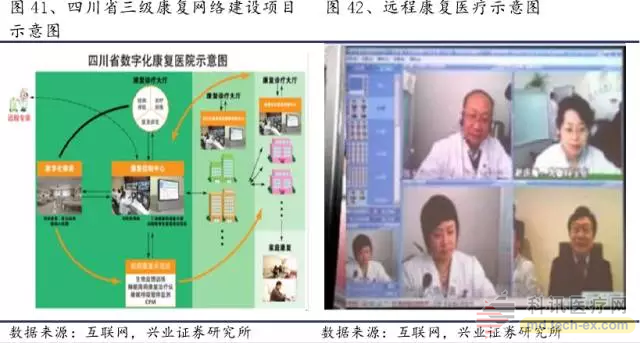
Summary: The report describes the policies, capital and new technologies of rehabilitation medical treatment, which reflects the more invented form of rehabilitation medical future development. With the synergy of policies, capital and technology, China's rehabilitation medical industry hundreds of billions of markets It is about to start and has a bright future.
IV. Overview of listed companies at home and abroad
1) Foreign related listed companies
Upstream medical device
ReWalk Robotics
ReWalk Robotics, an Israeli exoskeleton system provider, was listed on the NASDAQ in September 2014. The company manufactures wearable exoskeleton power equipment to help the athletes below the waist regain their mobility. ReWalk received EU certification in 2012 and entered the European market. In June 2014, ReWalk's exoskeleton products passed the US Food and Drug Administration (FDA). The approval is the first and only exoskeleton product approved by the FDA.
The company has two products, ReWalk Personal and ReWalk Rehabilitation. The former is mainly suitable for use in home, work or social environments. The sensors and monitors enable patients to stand, walk and climb stairs; the latter is used for clinical rehabilitation. Provide physical therapy for patients with delirium, including slowing the limb pain caused by sputum, muscle spasm, helping the intestinal digestive system, accelerating metabolism, etc. Stroke and cerebral palsy patients are also the target population of ReWalk in the future.
ReWalk is priced between $69,500 and $85,000, and the price of the product has affected the acceptance and audience of patients and older people to some extent. In the future, with the price reduction brought by the scale effect and the promotion of government subsidies and medical insurance, ReWalk is likely to be more widely accepted by patients and the elderly. 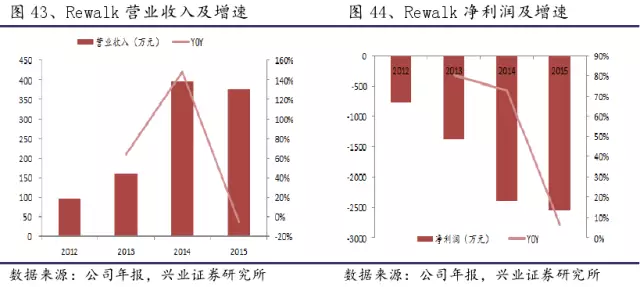
Ekso Bionics Holdings, Inc
Ekso Bionics was listed on NASDAQ OTC in 2014 and currently has a market capitalization of $94.7 million. Formerly known as Berkeley Bionics, the company is involved in the design and manufacturing of exoskeletons that enhance human function. It has been working with the military for more than a decade. In 2012, it began to study how to help the lower body. The company's design, development and promotion of exoskeleton or wearable machinery is used in a wide range of applications, including medical, military and industrial. Rehabilitation bionics exoskeleton for stroke patients, spinal injuries and other neurological diseases. Ekso's equipment is priced at over $100,000 and the company plans to further reduce prices in the future.
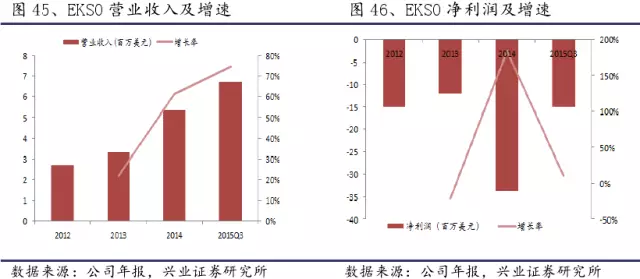
Downstream medical institution
HealthSouthCorporation
The company was founded in 1984 in Birmingham, Alabama, USA, and in 1986, the Nasdaq IPO, in 1988, transferred to the New York Stock Exchange. The company is the largest rehabilitation hospital chain in the United States with 34,700 employees and provides acute post-rehabilitation care services to 34 states in the United States. The current market value is $3.2 billion. In recent years, the company has continued to acquire rehabilitation hospitals on the one hand, and on the other hand, it has entered the related business areas of outpatient rehabilitation, home rehabilitation care and hospice care: the company acquired Walton Rehabilitation Hospital in 2013; and acquired the fourth largest home care service provider in the United States in December 2014. Encompass, enters home rehabilitation care, hospice care business; in October 2015, the company acquired Reliant to obtain 11 independent rehabilitation hospitals (the hospital has a total of 902 beds in Texas, Massachusetts and Ohio) . As the company continues to expand in size, the company's share price has risen six-fold in the past four years.
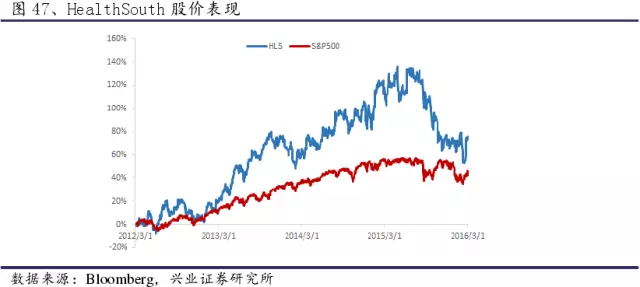
The company's business is divided into two parts: Inpatient Rehabilitation, Home Health and Hospice. The inpatient rehabilitation business is divided into inpatient and outpatient rehabilitation. According to the 2015 annual report, the company achieved revenue of US$3.12 billion in 2015, an increase of 31.2% over the same period of last year, and achieved a net profit of US$180 million; hospitalization revenue accounted for the largest proportion of 81%, followed by home care accounted for 15%, outpatient rehabilitation And hospice care accounted for 3% and 1% respectively.
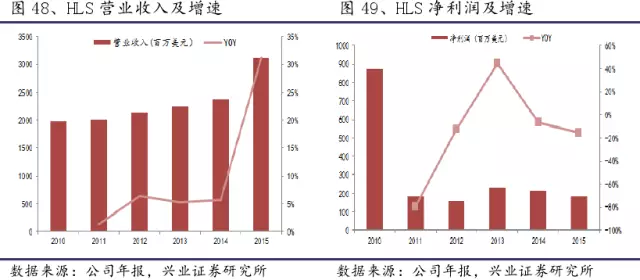
In terms of inpatient rehabilitation, the company currently has 121 hospitals with 8404 beds. In 2015, the number of outpatients was about 580,000, and the number of patients who were discharged from hospital was about 150,000. The company's rehabilitation hospitals provide comprehensive, professional diagnostic services and quality, cost-effective care. 92% of hospital patients are referred from acute hospitals. Most patients require inpatient rehabilitation services due to stroke, hip fracture, or neurological diseases. The hospital's rehabilitation team includes both rehabilitation doctors and nurses, as well as skilled physiotherapists and speech therapists to help patients repair their physiological and cognitive functions.
In terms of home care and hospice care, the company currently has 186 home care points and 27 hospice care institutions. Encompass, which was acquired by the company at the end of 2014, is the fourth-largest provider of home care services in the United States. After the completion of the acquisition, the company gradually transferred the majority of home care institutions previously operated to Encompass. As of November 2015, the company had 7 The 44 home care agencies and three hospice care facilities in each state were transferred to Encompass operations. Encompass's home care and hospice care facilities are widely distributed in 23 states in the United States. Patients admitted to home care institutions are usually referred to after acute treatment or inpatient rehabilitation. The hospice care center mainly provides for dying patients and their families. Services that help patients relieve pain, control symptom changes, and provide mental support.
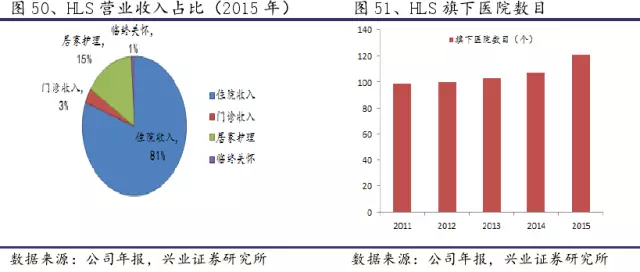
2) Domestic related listed companies
Upstream medical device
East Fulong
On May 27, 2015, the company announced that it has invested RMB 35 million to subscribe for 4.375 million shares of Shanghai Nuocheng Electric Co., Ltd., accounting for 14.77% of Nuocheng Electric's share capital, becoming the company's second largest shareholder. Nuocheng Electric expects net profit for 2015-2017 to be 9 million yuan, 15 million yuan and 23 million yuan respectively.
Nuocheng Electric was established in 1997. The company's main products include electroencephalogram, electromyograph, evoked potential instrument, intraoperative nerve monitor and other electrophysiological and rehabilitation products. It is a segment of electrophysiology and rehabilitation technology. "Little Giant". Electrophysiological equipment belongs to the conventional equipment used in hospitals, but it has been developing slowly. With the addition of sensors, data transmission and analysis technology, and Internet technology, ECG, EEG, and EMG have received more attention, and electrophysiological rehabilitation applications have also been Increasingly expanding.
Based on the technical advantages of hardware and software development of its electrophysiological rehabilitation system, Nuocheng Electric has led or participated in the construction of a three-level rehabilitation network project in some areas of Shanghai. At present, the Xuhui District Level 3 Rehabilitation Network Construction Project jointly promoted by Nuocheng Electric and Shanghai Sixth People's Hospital has completed the Sixth People's Hospital, Xuhui District Health Planning Committee, Xuhui District 2 Second Class Hospitals, and 10 Community Hospitals. Construction of a three-level rehabilitation network for demonstration sites.
Moving medical care
The company was listed on the New Third Board on November 12, 2015. The company's operating income in 2014 was 10.59 million yuan, and the net profit attributable to the mother was 514,000 yuan. The main products sold by the company are ventilators, rehabilitation products and nursing products. The products are mainly for secondary dealers and health service institutions such as hospitals and nursing homes. Rehabilitation products mainly include sports feedback training system and cervical and lumbar traction instruments. The Sports Feedback Training System is a series of active rehabilitation training and functional assessments for body joints and trunks launched by MediTouch, Israel. The products include HandTutor – Finger and Wrist Trainer, ArmTutor – Elbow and Shoulder Trainer, LegTutor – Knee and hip trainer and 3D-Tutor – full body multi-joint trainer. Qudbang TMB'POSTURE is the leading health product of B+ series of Bachmann Health Products Co., Ltd., which is used to solve and treat various spinal diseases caused by spinal imbalance and instability. It is a medical device that can restore the curvature of the spine. .
Downstream medical institution
Hunan Development
The company and Xiangya Hospital adopt a cooperation mode of not investing or occupying shares, and will be awarded the name of “Xiangya†brand in Bo'ai Rehabilitation Hospital. With the strong brand influence and medical technology of Xiangya Hospital, the company will cooperate fully. It has advantages in introducing the resources of Xiangya Hospital. Under the premise of the sharing of referral resources, Xiangya Boai Rehabilitation Hospital pays the cost of brand fees, technology usage fees, and multi-point practice of Xiangya Hospital. The two companies cooperate in the form of fixed fees in terms of brand name and technical support. When the number of beds exceeds a certain number, the two parties will further discuss the cooperation mode. The number of patients in the rehabilitation hospital is 8,600, and the initial estimates of patients admitted to a comprehensive hospital such as Xiangya account for about one-third of the total number of people.
Rehabilitation hospitals are particularly important for the survival of rehabilitation hospitals in the initial period by docking general hospitals to ensure the source of the disease. Some of the properties currently operated by Xiangya Boai Rehabilitation Hospital are in the form of leasing with a total investment of 130 million. According to the net profit promised, the initial investment cost is low and the payback period is short. Changsha Boai Rehabilitation Hospital is a three-level rehabilitation specialist hospital with 420 beds. The rehabilitation hospital was officially opened in the second half of 2012. In 2014, the income exceeded 100 million, and the profit and loss were balanced. President Zhou Jianglin promised a net profit of not less than 16 million in 2015-2017. 18 million or 20 million. The resources of the rehabilitation industry of Zhou Jianglin, the mature model of cooperation with comprehensive hospitals and the background resources of state-owned holdings constitute the unique resources of the “Xiangya Modelâ€, and also a powerful guarantee for the success of the chain layout in the whole Hunan Province. The Xiangxi and Changde Rehabilitation Hospitals are expected to open during the year, and the layout of Hunan's prefecture-level level will be completed in 3-5 years.
Aoyang Technology
In November 2015, the company issued a plan to increase the total amount of plans to raise 960 million yuan for project investment. The actual controller subscribed for 100 million yuan, of which 260 million yuan will be used for the construction of Gangcheng Rehabilitation Hospital and Rehabilitation Chain Hospital. The Gangcheng Rehabilitation Hospital will build a 10-story rehabilitation hospital building in accordance with the standards of the secondary rehabilitation hospital. The building will be equipped with rehabilitation departments such as bone and joint, nerve stroke, spinal cord injury and spinal cord injury. The scope of business diagnosis and treatment covers stroke sequelae and craniocerebral trauma. Post-cranial tumor surgery, various orthopedic surgery, multiple trauma surgery, child disability, neck and shoulder pain, myasthenia gravis, Parkinson's disease, chronic diseases of the elderly, and other ages, planning and verification The total number of beds is 300, and the total construction area is about 20,000 square meters. After the project is completed, it will become one of the most professional rehabilitation hospitals in East China.
The rehabilitation hospital chain project is based on the company's leading advantages in the operation, technology and talents of rehabilitation medical treatment. It selects areas with developed economy and lack of specialized rehabilitation hospitals in East China, and cooperates with local hospitals to build a rehabilitation medicine department. The cooperative hospital provides places and medical staff. The company assists the department in managing through various cooperation modes such as equipment support, technical support, and custody. The two parties distribute income according to the agreed proportion.
In the next three years, the company plans to cooperate with 30-50 hospitals to initially establish a rehabilitation medical network covering East China. The total investment of the rehabilitation hospital chain plan is 120 million yuan, and a total of 30 chain operation centers are invested. Each operation center has an average investment of 4 million yuan, which is mainly used for the purchase of rehabilitation equipment. It is estimated that the annual income of each bed is 14-15 million. Since this model is light asset investment, the gross profit margin and net profit margin are expected to be high, the gross profit margin can reach up to 40%, and the net interest rate can reach up to 20%. According to the company's current envisaged 50 beds in each chain, a total of 1,500 beds to calculate, the company can bring a net profit of 42 million to 45 million yuan per year.
Hejia shares
In April 2015, the company signed a Strategic Cooperation Agreement with Zhengzhou People's Hospital Medical Management Co., Ltd. on the establishment of a for-profit rehabilitation hospital. Zheng Medical Management Co., Ltd. holds 20% of the equity of the rehabilitation hospital. The two sides will use the rehabilitation hospitals set up as investment bases for long-term and in-depth cooperation in hospital management, personnel training, and technical exchange development.康å¤åŒ»é™¢é‡ç‚¹ç§‘室是神ç»åº·å¤ç§‘和骨伤康å¤ç§‘ï¼Œå¹¶åŠ›å›¾å°†å…¶æ‰“é€ æˆé«˜ç«¯è¿žé”康å¤åŒ»ç–—的领头羊。
åŽé‚¦å¥åº·
å…¬å¸åœ¨åŒ»ç–—æœåŠ¡é¢†åŸŸçš„布局将立足康å¤åŒ»ç–—,å‘专科康å¤æ–¹å‘å‘展。2015å¹´7月,收è´å¾·å›½èŽ±èŒµåŒ»é™¢ï¼Œå…¬å¸çš„收è´å°†å¼•è¿›å¾·å›½å…ˆè¿›çš„康å¤åŒ»ç–—ç†å¿µå’Œç»éªŒè½åœ°å›½å†…,为公å¸æ‹“展康å¤é¢†åŸŸç§¯ç´¯ç»éªŒï¼›å¹¶ä¸”有å¯èƒ½å°†èŽ±èŒµåŒ»é™¢çš„模å¼å¤åˆ¶åˆ°ä¸€çº¿åŸŽå¸‚,建立高端的康å¤ä¸å¿ƒï¼Œæ»¡è¶³å›½å†…日益增长的高净值人群的康å¤éœ€æ±‚。
国龙医疗
å…¬å¸äºŽ2014å¹´11月挂牌新三æ¿ï¼Œæ˜¯ä»¥éª¨ç§‘ã€å¦‡äº§ç§‘为特色的综åˆæ€§åŒ»é™¢ã€‚ç›®å‰ï¼Œå›½é¾™åŒ»ç–—旗下设立了分公å¸é“¶å·å›½é¾™åŒ»é™¢ã€åå…¬å¸å´å¿ 国龙医院以åŠä¸Šæµ·å›½é¾™åŒ»é™¢ã€‚2015å¹´4月,公å¸å…¬å‘Šä»¥å¢žèµ„扩股的方å¼å¼•è¿›ç›¸å…³å¢ƒå†…外的机构投资者,其ä¸åŒ…括PreferUS healthcareå’Œè”想控股,为公å¸çš„å‘展添上了“资本+技术â€çš„åŒç¿¼ã€‚è”想控股在国内资本圈已久负盛å,旗下有两家风投公å¸ï¼Œåˆ†åˆ«ä¸ºå¼˜æ¯…资本和å›è”资本;å¦å¤–,æ¤æ¬¡å¼•å…¥çš„技术方Prefer US是美国知å康å¤åŒ»ç–—机构,拥有100多ä½ç¾Žå›½å医,横跨骨科ã€å¾®åˆ›ç§‘ã€è„ŠæŸ±åŠåº·å¤åŒ»ç–—å¦ç§‘,在世界å„地å‡æœ‰æˆç»©æ–然的国际门诊驻点。
æ¥æºï¼šå…´ä¸šè¯åˆ¸
Livestock Industry Nitrile Gloves
Livestock Industry Nitrile Gloves,Blue Nitrile Exam Gloves,Powder Free Nitrile Medical Gloves,Latex Free Powder Free Nitrile Gloves
Puyang Linshi Medical Supplies Co., Ltd. , https://www.linshimedical.com